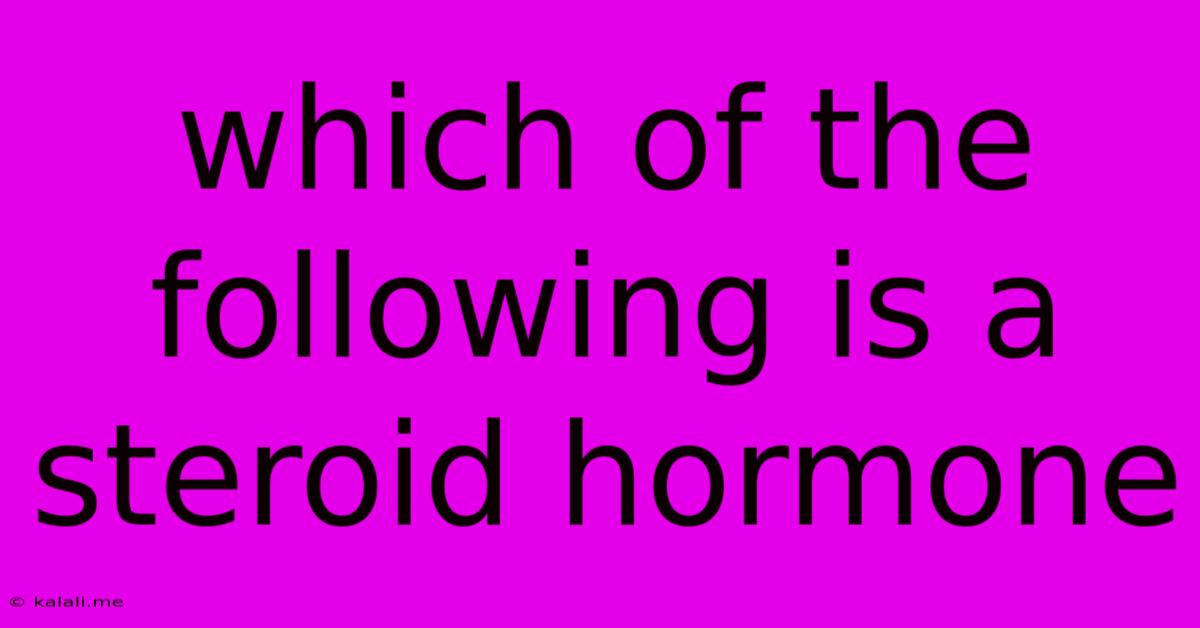Which Of The Following Is A Steroid Hormone
Kalali
Jun 15, 2025 · 3 min read

Table of Contents
Which of the Following is a Steroid Hormone? Understanding Steroid Hormone Classification
Steroid hormones are a crucial class of hormones vital for numerous bodily functions. Understanding their characteristics and differences from other hormone types is essential. This article will clarify what defines a steroid hormone and help you identify them. We'll explore the key features of steroid hormones and provide examples to illustrate the concept.
What are Steroid Hormones?
Steroid hormones are lipids derived from cholesterol. This fundamental characteristic distinguishes them from other hormone types, such as peptide hormones or amine hormones. Their lipid nature allows them to easily diffuse across cell membranes, unlike peptide hormones which require cell surface receptors. This unique ability influences their mechanism of action within the cell.
Key Characteristics of Steroid Hormones:
- Lipid-based structure: Derived from cholesterol, they are fat-soluble molecules.
- Intracellular receptors: They bind to specific receptor proteins located inside the cell, typically in the cytoplasm or nucleus.
- Gene regulation: Upon binding to the receptor, they form a hormone-receptor complex which then interacts with DNA, influencing gene expression. This process leads to the synthesis of new proteins that mediate the hormone's effects.
- Slower action: Compared to other hormone types, their effects are generally slower and longer-lasting. This is due to the multi-step process of gene transcription and translation.
Examples of Steroid Hormones:
Several crucial hormones fall under the steroid hormone umbrella, each playing a specific role in the body:
- Cortisol: A glucocorticoid produced by the adrenal cortex, regulating metabolism, immune response, and stress response.
- Aldosterone: A mineralocorticoid also produced by the adrenal cortex, crucial for regulating salt and water balance.
- Androgens (e.g., testosterone): Primarily involved in male sexual development and characteristics.
- Estrogens (e.g., estradiol): Primarily involved in female sexual development and characteristics.
- Progesterone: Plays a vital role in the menstrual cycle and pregnancy.
Differentiating Steroid Hormones from Other Hormone Types:
To effectively distinguish steroid hormones, consider these contrasts:
- Peptide Hormones: These are protein-based hormones that bind to cell surface receptors, triggering rapid cellular responses through second messenger systems. Examples include insulin and glucagon.
- Amine Hormones: Derived from amino acids, they can act through various mechanisms, some binding to cell surface receptors, others acting intracellularly like steroid hormones (e.g., thyroid hormones).
Identifying a Steroid Hormone in a Multiple-Choice Question:
When faced with a multiple-choice question asking to identify a steroid hormone from a list of options, focus on the characteristics described above. Look for hormone names associated with the adrenal cortex (cortisol, aldosterone), gonads (testosterone, estrogen, progesterone), or those known for their role in regulating metabolism, stress response, or sexual development.
Conclusion:
Understanding the unique characteristics of steroid hormones, such as their lipid-based nature, intracellular receptors, and mechanism of gene regulation, is critical for recognizing and distinguishing them from other hormone classes. This knowledge is essential for grasping their vital roles in maintaining bodily homeostasis and overall health. Remember to focus on these key features when identifying a steroid hormone from a selection of options.
Latest Posts
Latest Posts
-
How Many Valence Electrons Are In H2o
Jun 15, 2025
-
Which Of The Following Is Not An Example Of Scaffolding
Jun 15, 2025
-
Sam Houston State University Gpa Requirements
Jun 15, 2025
-
Hammer Is To Nail As Screwdriver Is To
Jun 15, 2025
-
What Is The Gas Released During Photosynthesis
Jun 15, 2025
Related Post
Thank you for visiting our website which covers about Which Of The Following Is A Steroid Hormone . We hope the information provided has been useful to you. Feel free to contact us if you have any questions or need further assistance. See you next time and don't miss to bookmark.